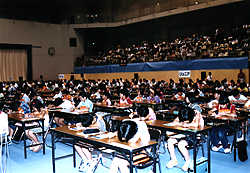|
 The
Japanese Soroban Grand Prix (soroban is a Japanese abacus) for
2000 was held in Tokyo recently to determine who was the most accurate
calculator on the abacus, and elementary schoolchildren ranked with
adult participants in the annual championship. The
Japanese Soroban Grand Prix (soroban is a Japanese abacus) for
2000 was held in Tokyo recently to determine who was the most accurate
calculator on the abacus, and elementary schoolchildren ranked with
adult participants in the annual championship.
Some 300 participants, all winners
of prefectural preliminary tournaments, competed for the titles in four
divisions: mental calculation of numbers read aloud, abacus calculation
of numbers read aloud, an all-round individual event, and an inter-prefectural
competition. The all-round individual event was divided into the three
groups: the "junior" class for elementary schoolchildren, the "school"
class for junior high and high school students, and the "senior" class
for adults. A grand champion was chosen for each division and class.
Sixth-grader Ittetsu Suzuki from
Hokkaido, who hoped to win the junior all-round individual title for
a third consecutive year, lost out to fifth-grader Sachi Watanabe from
Miyagi in the final. As many as 105 kids took part in the junior class.
 Sachi,
who achieved a perfect score, said, "I'm very happy because I really
didn't expect to win." She practices the abacus two and a half hours
every day, but said with a smile she needs to do more to become "faster
and more accurate." Sachi,
who achieved a perfect score, said, "I'm very happy because I really
didn't expect to win." She practices the abacus two and a half hours
every day, but said with a smile she needs to do more to become "faster
and more accurate."
The individual event involves five
kinds of calculation: multiplication, division, mental calculation,
abacus calculation of written problems, and calculation of invoices.
The person with the highest combined point score for the five categories,
all done in less than a minute, is named the grand champion.
Despite his loss in the combined
individual event, Ittetsu vied with adults in mental calculation of
numbers read aloud and received the prize for excellence. Sayaka Matsuda,
a sixth grader from Ishikawa Prefecture, got the same prize in abacus
calculation of numbers read aloud.
The abacus is believed to have come
to Japan from China in the late 16th century. The standard abacus currently
in use in Japan has 21 to 27 rods, with five beads sliding freely on
each rod--one signifying the number 5 and each of the other four the
number 1.
 Despite
such a long tradition, unfortunately the number of abacus users is steadily
declining. The abacus helps develop the power of numerical calculation
and memorization. It is said to be particularly effective if children
learn to use the abacus while they are young and their brains are still
in the development stage. Despite
such a long tradition, unfortunately the number of abacus users is steadily
declining. The abacus helps develop the power of numerical calculation
and memorization. It is said to be particularly effective if children
learn to use the abacus while they are young and their brains are still
in the development stage.
An official at the League of Japan
Abacus Associations, which organized the competition, said abacus calculation
was "part of Japanese culture that should be carried on into the 21st
century." "We want more and more schoolchildren to learn how to use
the abacus," the official said.
Photos (from top): Competitors at the abacus tournament;
a typical Japanese abacus; some kids joined the adults on the winners'
podium. (The League of Japan Abacus Associations)
|

 The
Japanese Soroban Grand Prix (soroban is a Japanese abacus) for
2000 was held in Tokyo recently to determine who was the most accurate
calculator on the abacus, and elementary schoolchildren ranked with
adult participants in the annual championship.
The
Japanese Soroban Grand Prix (soroban is a Japanese abacus) for
2000 was held in Tokyo recently to determine who was the most accurate
calculator on the abacus, and elementary schoolchildren ranked with
adult participants in the annual championship.  Sachi,
who achieved a perfect score, said, "I'm very happy because I really
didn't expect to win." She practices the abacus two and a half hours
every day, but said with a smile she needs to do more to become "faster
and more accurate."
Sachi,
who achieved a perfect score, said, "I'm very happy because I really
didn't expect to win." She practices the abacus two and a half hours
every day, but said with a smile she needs to do more to become "faster
and more accurate." Despite
such a long tradition, unfortunately the number of abacus users is steadily
declining. The abacus helps develop the power of numerical calculation
and memorization. It is said to be particularly effective if children
learn to use the abacus while they are young and their brains are still
in the development stage.
Despite
such a long tradition, unfortunately the number of abacus users is steadily
declining. The abacus helps develop the power of numerical calculation
and memorization. It is said to be particularly effective if children
learn to use the abacus while they are young and their brains are still
in the development stage.